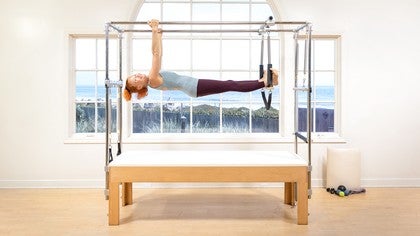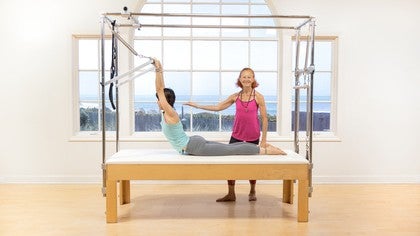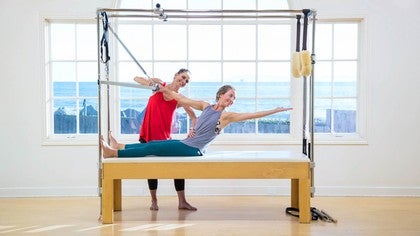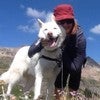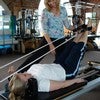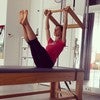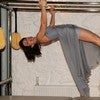Description
About This Video
Transcript
Read Full Transcript
The theme for today's class is potentiating and working on our upper backs; our rib cage, our shoulders, and creating this posture that we all want, which is more vertical with the integrity and strength to support it correctly. We tend to have this rather rounded shape. It's built into the culture now because we sit so much, we spend so much time in front of the computer. So the tissue and the connective tissue in this part of our back gets very atrophied and glued up and stuck. So before I start to exercise, I always want to loosen the area and release it.
This is a tennis ball. You can use a Tune Up, a Yamuna ball, a Franklin ball. Just allowing the ball to move between the shoulder blades to make them wide is what we're going to do. I'm going to be taking the ball and going from the spine towards the shoulder blade. The very important part is to take those shoulder blades and widen them because this is exactly the area that got atrophied and kind of crunched up and tight and doesn't work very well.
So we want to potentiate that so then we can develop muscle structure there. I've got my ball, here it is. Somewhere in the area of the shoulder blade, between the shoulder blade, and now I'm just moving around and finding where it's tight. As I get it close to the shoulder blade, I'm really digging in to push the shoulder blade wider. Even if the shoulder comes forward, don't be concerned with that, that's a problem of your pecs.
So you want to create this width and press into the tissue in the area. And if you find a very tight, hard area, take your time and spend more time there. I'm just demonstrating right now to give you concept. We're widening the back. I'm moving back now and moving the ball over to the other side.
And again, I'm moving from the spine out away from the spinal column. Got my elbow up in order to make my shoulder blade wider. My aspiration as I'm doing this is to create as wide a back as I possibly can. And I can feel into the areas of the muscles that are very tight rigidified painful. Moving up.
I'm coming higher up towards the top. And then coming off the ball for a minute. When you come off, just check to see, you can probably already get a sense of your back being wider. We want a wide, long, straight back. That's our goal.
The next area would be the shoulder blade itself. This whole area on the side, the shoulders are quite wide and they can have a lot of, again, static rigidified underactive muscle tissue. So I'm taking the ball, got it on my shoulder blade, and then just moving around in there to find... Whoa, (laughs) where the tissue is tight and start to mobilize it. My goal every time is to get the shoulder blade as wide as I possibly can.
I'm going all the way up into the deltoid. And I have a few pockets of areas that are tight. I'm going to do the other side. And again, roll out those areas, stimulating them. Whoa, whoa, the ball keeps moving. (laughs) Here we are.
And working into that shoulder blade area. And then lying on my back to check. Does my back feel broad already? I feel that the shoulders are relaxing further down because the back has been widened a little bit. The next area to potentiate, we want this broad back, is the pecs.
I would say that, for most women, the pecs are very underdeveloped. If you think of it, it's this huge shaft of muscle in the front of the chest. We are going to work right in here. If you start to open up one area, it will have a repercussion into everything else. This is usually the area that is tight and constricted, no circulation is coming in there.
If I took my collarbone, down to the armpit, it's right in this area that I will be working into, just moving around, finding those sweet little tender areas. I'm placing the ball right into there and moving around in here. If you are big breasted or you have a client that's more gifted anatomically, you can place the ball on a yoga block so that you're raised up. And then you can get the pressure right into the area. You're not looking at going into breast tissue, you want to work around the armpit, in the front of the armpit, up to the collarbone.
I'm moving to the other side just to do the same thing. Again, here is my collarbone, down to the armpit. Stimulating this area because I'm going to be exercising it in a minute and working through this area to warm it up, get any adhesions out and potentiate the tissue so it's ready to start to be active and involved and not so tight and dry. Allowing myself to sink in a bit. Next, we'll be rolling out the trapezius, which is everybody's challenged area.
If you think of your neck going down and your shoulders coming out, it's this area right at the top that gets so grippy, and tight, and massed up together. So you want this ball, if I'm bending over, I'm right into this area, and find a doorframe in your house that you can lean into and use the pressure into the ball to dig into that tissue and start to soften it up and just kind of hang out here for really two minutes. That's when the deeper changes are happening, 'cause the tissue will get softer and softer and start to give up some of its rigidity. I'm gonna do the other side now. So again, coming into the top, the most fibrous area, leaning into the corner, and allowing taking a bit of time to relax and release and get deeper and deeper into the area and start the traction at a little bit.
And coming up. I recommend doing it for a little bit longer than we did it right now to get those benefits happening. But now that the body has been a little bit lubricated, the tissue has been stimulated, we're going to start moving into movement. And I'd like to connect the whole chain of the arm into the shoulder and the trunk. So we'll start with one hand and turn your hand out.
Imagine you have a pole running through the middle of your finger into the wrist, so that's kind of the first rotational space, and rotate the arm as far as you can outwards keeping the hand right at the side. Start with the hand. You're spiraling around that pin, you could say. So I'm focusing now on my hand in relation to my wrist, in relation to my forearm. I'm continuing the movement into the elbow, into where the arm bone connects, into the shoulder, and then all the way through into the shoulder girdle and into the shoulder blade.
And I'm allowing the repercussions of the movement to go into my chest. So I'm actually rolling the whole area in one direction. Then I'm starting from the shoulder blade, through the arm, through the elbow, through the wrist, through the hand, all the way back. So we're wringing out the tissue of the arm and activating it because we have lots of areas that are sticky and tight and locked, and we tend to hold our body in rigidified shapes, and we want to be juicy and mobile and flexible and stimulated. So lots of hydration coming all the way back.
Other side would be the same thing, that pin through the third finger to get a rotation. And an aspect of it, it's like you're moving around a pole. I'm starting with my wrist, my hand and my wrist. And it goes into my forearm, and it goes into the elbow, and it goes all the way to the top of the arm, into the shoulder, the deltoid, shoulder blade, and then into the whole chest. So now we're connecting it into the traps, and the lats, and the whole trunk body.
Reversing it, the shoulder blade starts to roll back; elbow, wrist, hand, all the way through to the tips. Again, I'm moving through the wrist, the arm, the elbow, the upper arm, the shoulder, the shoulder blade, and I'm allowing the chest and the trunk to respond to the spiraling and moving back in the other direction. So we're starting to just get all of this nice juicy movement back in the body. Now we'll do both at the same time but opposite to each other. So my left hand, I'm internally rotating, my right hand, I'm externally rotating, and now I'm going to work the reversal of it.
I'm going to start with the shoulder blade on the left, the hand, rolling through. And notice that the trunk is dancing in between these two movements. And I'm starting to really get a lovely stretching in my chest, all through the shoulder blade and out into the hand. Again, the hand starts on one side, the shoulder blade starts in the other rotation. And then the other side, 'cause we have these spirals of movement and muscular patterns in our body, and we usually just use about 2% of them.
We're going to add something to the side that's turned in. I'm turning my head and looking in that direction. So as I start to move the whole arm, I'm also bringing in the spiraling of the head in our position and attempting to do this keeping my eyes gazing straight forward. So my chin is not going up or down, but I'm just rotating. And this starts to free up the trapezius and the neck in relation to the trunk.
So we're just, again, warming up the body, getting things juicy. You will start to feel your whole body wake up, your upper body, I should say, because we're now beginning to use every muscle in the trunk; your lats, your traps, your rhomboids, your shoulders, trapezius, and the front of your body, your pecs. It should feel really sensuous, juicy and kind of like, you know when you wake up in the morning, you'll... (Niedra groaning) And a cat will stretch, and a dog will stretch. It's that kind of a feeling that's happening.
You're just squeezing everything, you're pulling everything, you're stretching everything. And then you feel wide awake and vibrant. So go for that feeling because it's wonderful. One more thing before we actually start formal exercise is tractioning our body. So we're taking the whole body and making it long.
I've got a yoga strap here. Improvise at home or in your studio, depending upon what your set of circumstances are. There is a way to do this. If you have a chin up bar, a tree with a branch, you can drape over, but you want something that you can pull on and actually... Look at this.
This is what's going to maybe be different for you. I'm actually pulling my shoulders up, not down. Up because it opens up the traps very widely and it opens up the broadening of the back. And that's what we're looking for. So you want to pull down with the hand and pull the shoulders up and then see if you can get the trunk very long.
So with my feet, I'm slightly bending my knees to create as much length in the waist area as I possibly can. And I'm just giving the full trunk length and I'm attempting to go as straight as I can. So if I was to look at myself sideways or demonstrate sideways, most people, because we have an underdeveloped... Or, we have a lot of talent, I should say, still to develop. So I'll end up being in a shape like this.
And we're looking to see how much length can I get in my lumbar spine, how much length can I get in my rib cage, and then how much length can I get right here up at the top so that you have this whole spring being pulled out. So I'm gonna do this one more time. It should feel wonderful. Your waist area should get about two inches longer. If you do this enough times, you will actually get taller in time.
So my shoulders are coming up. My shoulder blades are getting wide in the back, not narrow. I'm not crunching back, I'm actually widening my back. This area should start to fire extensively. Imagine every rib separating and then separate out the waist area.
So you create this massive length in the trunk to just get yourself ready for working out and feeling great. Once I've done that, warmed up, clients, by the way, love doing this, it becomes such a nice openness of the nervous system. We'll start working into the upper body a little bit more with a barrel. It can be spine corrector, barrel, anything that's round because we tend to be rather stiff and tight in our upper backs. I have two little weights here.
And I want to take the barrel below my shoulder blades and attempt to lengthen out the neck. From here I'm having a very slight length of my lumbar spine in opposition because the area that I'm working in is where we get very rigidified and tight. Each person is a little bit different, and this is what's different. I'd like the shoulders forward not drop down. And I'd like to shoulders just a little bit up just for a minute.
When the shoulders are forward, I can use more pressure into where the barrel is. And to begin with, let's have the shoulders coming way up and over the head. So now I've got a huge stretch into my pec area and into my lats. And that's what I'm looking for. So don't be afraid to lift your shoulders up and let them open.
It may feel a little bit counter-intuitive at first, but it will open up your lats and your back very powerfully. And if you look at a lot of top gymnasts and many different types of athletic sports, the shoulders are very mobilized. Before I move on, I'd like to demonstrate something. If you look at somebody who's throwing, the shoulder comes forward, it's not held back. The whole power is a full trunk position.
And I found that sometimes, me very much included in this, I was so preoccupied with always having the shoulders back and connected to the body that I created a lot of rigidity in the area. And this mobilization of the shoulders allowed it to move to a whole other level of power in my own body. Also, if you look at gymnasts or people who lift things over their head, if they were actually pulling up, this opens up this whole side. So that's what you're going for. We're going to move a little bit higher now and the same thing again.
So I hope now you can see I'm letting my shoulders come up and it's creating a huge traction in the rib cage, and that's what I'm looking for, so that when I work my arms and exercise my upper body, I have full potential. Now you will start moving one arm at a time. So a lot of lengths in the serratus muscles or in the sides of the ribs. Joseph Pilates used to talk about this accordion shape that we had as potential that each rib should be able to open. As you're moving your arms forward and back, check also that the elbows are long, not necessarily locked, but very often, if the muscles are tight, a client or a person will work with the elbows bent.
Or if they're super flexible, they hyperextend the joint and they're not tractioning the tissue of the muscle, which is what we want to really wake up and potentiate in order to have a healthy body. So just use this, enjoy this reach of the arms, feel the tractioning on the side of the ribs as each arm goes up, and you will find it when you come out of this, you should feel a whole lot better, more awake, more open. Next, we're going to wake up and stimulate the lower body. So we're going into the roll-down bar. I would like to invite you to start with your knees bent and the heels slightly away from the bar, so you can get more lift.
So as we've already gotten focused into the upper body, how much can you get traction? Just like you did when you were pulling on those straps. And just for a minute, if you pull the shoulders up, I'm sorry, I know this is counter to what you've been thinking about forever, can you lift up your side ribs even more and then just allow the shoulders to be very relaxed, but forward to spread between the shoulder blades. The goal is to get a straight a spine as you can. And then when you start to roll down, don't pull the shoulders down into your back but keep them coming forward but get the length through the high part of the back so you get as much length as possible.
I'm going to pull the bar in three times. And then roll up, pulling the head in. Right here I'm broadening the shoulder blades as much as I can and creating a lot of lengths in the thoracic spine. Rolling back up. Lifting up the spine even taller.
So again, I'm letting the armpits lift me a little bit to create even more traction through the rib cage. Eventually the whole rib cage flattens out and widens. That's what we're looking for. One more time. Rolling down.
Pulling in three times. Notice that my shoulder blades are very wide. I'm not working with my shoulders on my back, but I'm actually working into my lats. Coming in and sitting up straight. A fun way to work this to get even more focus into the lower back and also get traction into the lumbar spine is if your feet are on the bar, because it'll give you a little bit...
Do you see how I have a little bit of a wedging into the lower part of the sit bones? So same lift, same length, but the legs are bringing a little bit more traction into the lower part of the lumbar spine, getting length three times. So these are just enjoyable variations. Now it's opening up and widening my middle back enormously. And I want as much length, and as much space, and as much muscle power as I can possibly dredge out of this body and any other body I'm working with by using as much talent or potentiation as I can possibly do.
Once the back has been warmed up, you want this feeling of breadth and width. We'll go into some arm work. So from here, I'm going to be on my back. Arm springs. I like to have the hands right above the shoulders.
And this is where I look for this very, very broad back. I'm taking those shoulder blades and I'm spreading them as wide apart so that I can get this whole wide part of the back firing and active. I'm also allowing the shoulders to come up just a little bit to get even more length in the rib cage area. From here, I start to pull down. And if you're doing it right, you should feel the sides of your ribs working a lot.
That means you're activating into your lats. And I'm also allowing the hands to reach up and out. So it actually creates a huge tractioning through the body. How far down you go is an irrelevancy 'cause we've different strength levels. Sometimes those muscles are very weak for a lot of women that haven't worked this way before.
You can always be further up and then you'll be able to hit into the lats from slightly lower down in the rib cage. So we want all of this connected up so we have a strong, stable trunk power. Moving to the side, same thing. I'm first starting with the armpits up, getting as much breadth as I possibly can in the shoulder blades. And then from there, it's like someone's under your armpits pulling them up as you bring your hands in towards your thighs.
And it will start to get the whole side of your body hugging up but creating a lot of length. I'm doing this one more time. And then starting to bring the arms through a full circle in the frontal plane of the body. I like to have the hands touch because my intention, especially with women, because we tend to not have this area challenged, I want the pecs to start to wake up because it will keep so much more verticality available. Reversing it.
Little arm circles reaching the arms out and down. As I do this, I'm looking for the lengths in my whole trunk and little movements here. Reversing it. I'm constantly stretching through the fingers and then coming into the triceps at the end of this set, just having the elbows down. Now, the shoulders may be a little bit forward.
I'm more interested in wide collarbones and wide shoulder blades. I allow the shoulders... When the shoulder can come up a little bit, the tip of the shoulder naturally starts to go where it belongs, which is facing straight up. Normally people are a little bit in this shape because there's a lot of tightness and sometimes over education along one plane of knowledge. So moving through this, lengthening the arms out, and then relax.
And before we go into where all of this work has been leading us, which is standing arm springs, I'd like to go over some of the basics when you get into punching, which is a huge shift in the shoulder girdle. You have this nice long back broad shoulder blades, activated abdomen, wide chest, and your arms will be... Your elbows are probably to the side. So this is a position anybody can get into on their back. From here I'm just taking one arm forward.
Now, I'm bringing it in front of my chest. And this is what I would like to reach for, is this punching. Notice how the shoulder blades moved round the side and the chest actually contracts a little bit. Other side will be the same thing. The shoulder blade is wrapping around and then reaching up.
So there's a ringing out of the trunk that happens to power the movement forward. Very, very useful to free up and bring a lot of power into the upper body. So ringing that side body out, ringing the side body out. The other thing I check with my clients and with myself, 'cause I'm my own client, is, with the elbows up, I'm going to bring... The elbows come in, kind of like we were just doing the triceps, and I'm going to bring one elbow across.
Now, when you bring the elbow across your body, you're activating your pecs. This area is so weak for so many of us. And then as I push out, again, the shoulder comes forward, and then I'm bringing the elbow back. Same thing, the elbow... Notice, I'm pulling the elbow in but I'm contracting my chest tissue to get power into this part.
This sorts out a lot of rotator cuff issues for people, by the way, because they just haven't worked the full range of what the shoulder girdle can do. So I run through this variation a few times. So people have that concept of how to ring themselves up. Now we get to really have fun with our standing arm springs, applying everything we've been working up towards. So to begin with we'll do hug a tree.
The focus is actually this contraction of the front muscles in here, which we sometimes are so scared of doing because we always want to look gorgeous and open. But we need those muscles, and they will mean that you can be open and stable and strong. So finding your balance point, finding that place where you're leaning into the spring, connecting into that long trunk again. Here we go. Always finding the length first, and then can you contract without necessarily rounding this way?
That's cathartically overworking in the upper back and we want to broaden the shoulder blades. Broaden them and wrap them around, and your whole lap muscles will start to work massively. We want that. So good to do. Close and then open without losing it.
One more time, activating those muscles a lot and then coming back. Next one will be shaving. I'm taking my hands and I'm doing the salute, actually. So it's triceps. So again, I'm widening these shoulder blades and wrapping them around the side.
The elbows are quite a bit forward, but I'm not here. This is the whole point. Can you get as much length as you can in your upper back? Lean in, and then as you extend, you keep reaching the spine and make it longer. And you will start to feel the whole body wrapped in a corset, which is what we are always striving for with all the work that we do in Pilates.
And one more time, getting as much length as I possibly can and then resisting back with care. The next variation of shaving, which I love, is for stretch more than anything else. And here we get to open the elbows. Notice one more thing: I'm actually allowing the shoulders to come up. I'm not keeping them down.
It exposes all the tightness in the high pecs. And keeping the elbows as wide as I can. I'm not working into the spring as much as using the spring to give me traction through the side. This is a huge stretch into the lats and the side of the ribs. And I have never met anybody that didn't grow an inch and feel happier when they went through this experience because it's ringing out some very tight patterns that we tend to accumulate because the shapes we go through on our day daily life are very limited, and we are designed to have amazing qualities of experience in this body.
So opening the side ribs, tractioning the side arms. I'm going to do this one more time. Notice I'm actually not working into the spring at all. Lengthening it up. So now I'm activating my whole side body, opening the ribs and coming down.
Now the fun part. Now we get into the punching. So the elbows are up for this first variation. Again, leaning in. And now I'm finding my pecs and then stretching out and then I'm rolling the shoulder forward.
So I'm massively rotating into this position and it's activating the whole trunk, bringing the elbow back. Other side, going forward, rolling the shoulder forward and using the whole rib cage to push and coming back. So this is slow motion boxing, but if you ever looked at a boxer, they have a huge amount happening in their trunk and they develop the massively powerful shoulder girdle, and hardly ever get rotator cuff problems. Working into it. So don't be afraid to let the rib cage rotate.
Once you found all these muscle groups, it's going to kick into your obliques as well. Just enjoy punching out the world and becoming strong and beautiful and powerful as you do this. So once you have the flow, enjoy punching out the world, feel how you're wringing out your ribs and activating your whole upper body. And your posture should feel amazing because you've energized everything and woken up your body. Now we're going to do pull ups on the trapeze.
So I'm going to get mine and go and set up yours. Okay, so the trapeze bar is set up and coming to a standing position. Traditionally, people often would measure their arm length. The most important thing that you want when you're setting yourself up for pull-ups is, once your feet are in, that you check to see that your arms are in line with your shoulders. So you can be in a plank position on your back, basically.
Now, this is where it's interesting. I'm actually letting my shoulders go wide but I'm keeping my back long versus trying to hide my shoulders onto my back. I'm letting the shoulder blades widen up. Occasionally I will let clients do a few of these so they really can find the muscles that are connected to the area. Once you're set up, you've activated your trunk, three pull-ups.
And notice that if the shoulder blades are wide, you probably have a lot more room and a nice stretch through the whole body. This feels so good after all of this work. Opening up the tissue, creating length, going into your back bend. When you go into the back bend, watch that you get the upper back to work. We're not looking at the lower back, we're looking to open up the chest as much as possible and get the thoracic spine to move.
One, two, three. Nice, length down. Stretching everything out, I love this, I haven't done this in a long time, and then coming into a back bend. Opening the chest, getting the upper back to really activate and expand. And stepping out.
So delicious. Just for fun for the athletes among you, see if you can hold, even if you can't get your feet off, but if you can, can you lower yourself down because we're working in upper body strength today and length, and then maybe, I highly recommend if you're too short, you can be on a box. Traction yourself, just feel like a kid hanging off of a bar. Get as much length as you can, wiggle yourself around, get all the kinks out. And I hope you'll feel great, energized and happy.
Tower & Cadillac Workouts: Beginner Cadillac Workouts
Comments
You need to be a subscriber to post a comment.
Please Log In or Create an Account to start your free trial.
